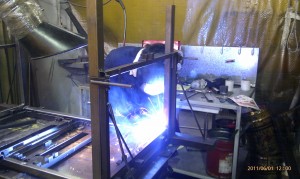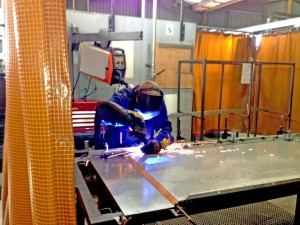Haztek provides welding fume monitoring and assessment services for manufacturing, construction, mining and maritime industries.
Health Effects Welding Fume and Gases
The fume and gases given off by welding and hot cutting processes is a varying mixture of airborne gases and very fine particles. When if inhaled welding fume and gases can cause illness including;
- Pneumonia;
- Poorly designed LEV
- Occupational asthma;
- Cancer;
- Metal fume fever;
- Irritation of throat and lungs;
- Temporary reduced lung function.
One of the most commonly observed health effects from exposure to welding fume is metal fume fever, which often resembles an upper respiratory tract infection, such as influenza, pneumonia or acute bronchitis. Metal fume fever usually lasts 6 – 24 hours and is accompanied by chills, aches, trembling, nausea and vomiting.Ozone is formed during most electric arc welding, and exposures can be high in comparison to the exposure standard. Oxides of nitrogen are also found during gas welding. Pneumonitis and pulmonary oedema have been reported in welders who have performed various welding processes and were exposed over short periods to high concentrations of ozone, nitrogen dioxide and iron oxide fumes.
Our Approach to Welding Fume Monitoring and Assessment
Haztek focuses on designing exposure assessment programs appropriate to your organisation. The most suitable program for your organisation may involve air monitoring or the use of alternate assessment methods such as surrogate data, modelling or control banding. Our consultants will design efficient and effective exposure assessment programs specific to your needs.
Welding Fume Monitoring / Testing
Monitoring is undertaken to determine the concentrations of welding fume and gases that workers breath while work is undertaken. Monitoring for welding fume and gases may be required as part of the assessment of risk where it is necessary to obtain a quantitative estimate of exposure.
Welding fume monitoring for workers is conducted in accordance with the requirements of AS 3853:2006 Health and safety in welding and allied processes – Sampling of airborne particles and gases in the operators breathing zone.
When conducting welding fume monitoring a pump and a sampling head are fitted to the welder while work is undertaken. The samples are analysed by a NATA accredited laboratory for welding fume and selected metals.
Welding Fume and Gases Exposure Standards
The Safework Australia Hazardous Substance Information System (HSIS) has established a TWA ES of 5 mg/m3 for welding fume, this is recommended to minimise the potential for irritation and adverse pulmonary effects.
The Safework Australia HSIS has established a TWA ES of 0.1 ppm and a Peak of 0.2 ppm for ozone, this is recommended to minimise the potential for irritation and adverse pulmonary effects.
Welding Fume Control
Our consultants have extensive experience developing control measures for welding operations. We can provide guidance on the effectiveness of on-gun extraction system, local exhaust ventilation and respirator protection.
Emphasis is placed on ensuring that the strategies developed are practical and can be readily implemented and understood by operational personnel.
For further information on how we can assist you with welding fume monitoring services call our office or use our contacts page to forward a request for further information.












